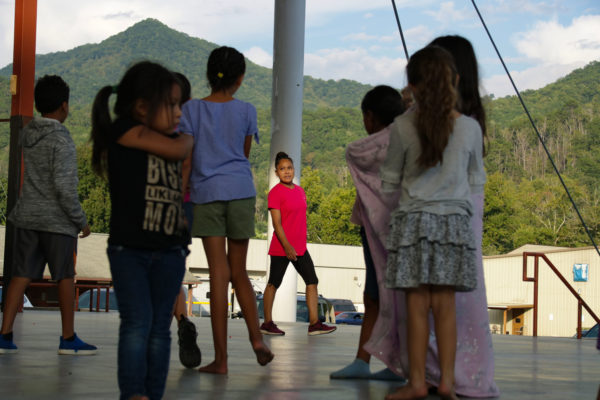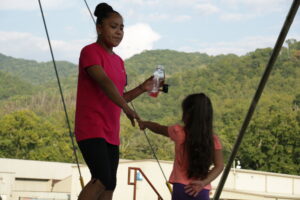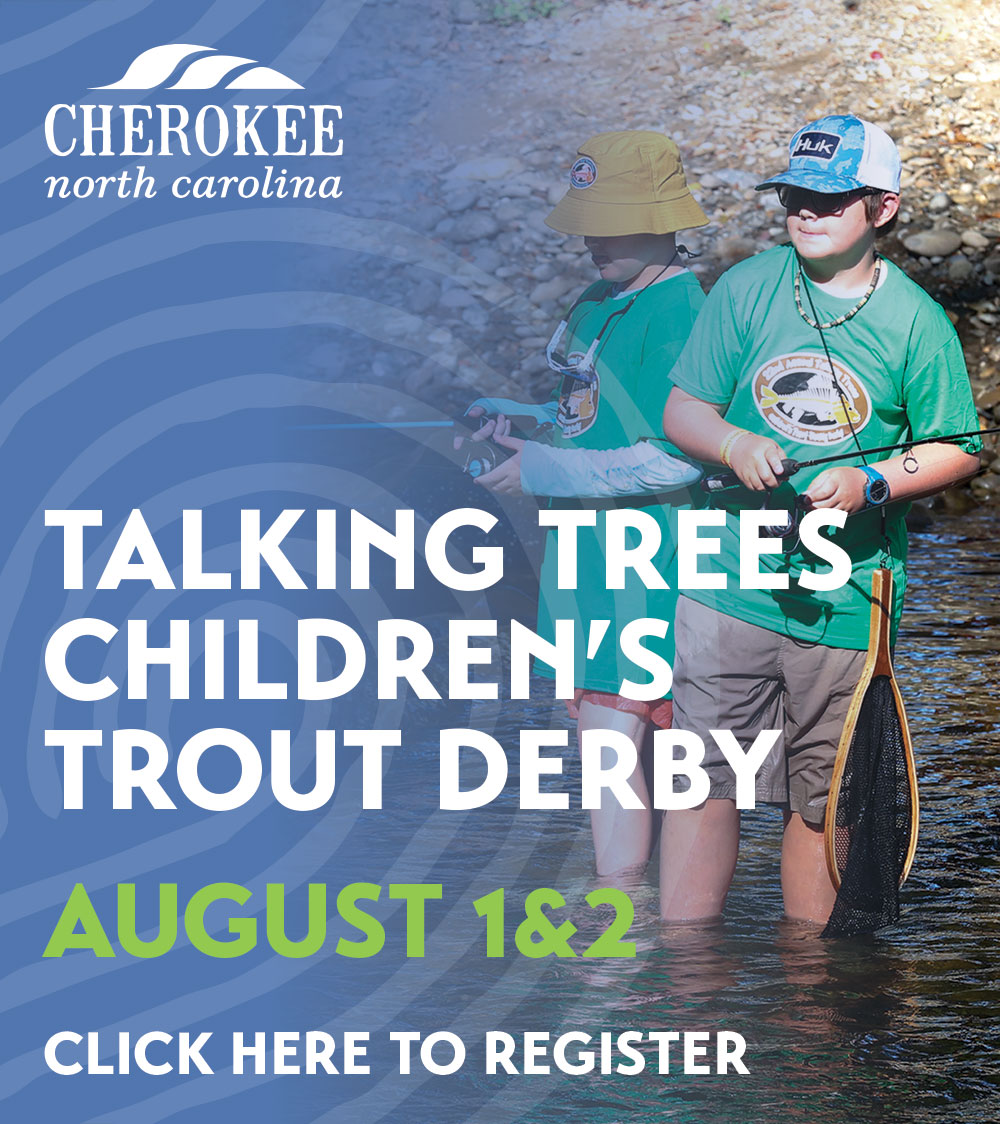
JaTanna Feather, background center, works with young pow wow style dancers in her group, the Kanohesgi Storyteller Dancers, at the Cherokee Indian Fairgrounds on a Wednesday evening. (JONAH LOSSIAH/One Feather photos)
By JONAH LOSSIAH
ONE FEATHER STAFF
JaTanna Feather takes a long look at her dancers.
A few dozen pairs of feet bounce off the stage at the fairgrounds. It’s a Wednesday night with class starting at 5:30 p.m. This time each week is significant. Not just because it’s one of the first classes of its kind or that it’s offering cultural practices for these kids.
This course is crucial for Feather as a person. It represents hope, progress, and a glimpse at normalcy.
It has been a long and terrifying path to get to where she is now. She’s danced since she could walk and started competing when she was just five or six years old. She won countless awards for dancing fancy at different pow wows as a kid. But, now it means so much more. It’s a sanctuary.
Feather moved to Tahlequah, Okla. for her senior year of high school. She wanted to see what life was like away from home, and she got to play for a new basketball program, which had become her passion at that time.
Entering that year something wasn’t right.
“I just remember having a lot of pain. A lot of pain throughout my arms, throughout my legs. You know, most mornings I couldn’t even get up out of bed. I would have to take pain medicine to get out of bed.”
It had all started that summer after she had been in a car wreck. Slowly since that day, her pain grew. She remembers visiting the Indian Hospital in search of a solution, but all they could give her was pain medication. In February of the following year, it got to be too much.
“It was so bad; I couldn’t move. Even if I took the pain meds, I could not move. So, my dorm mother, she rushed me to the hospital.”
Feather was given a steroid shot in her leg to help deal with the pain. Within minutes, her leg started to swell. Nobody knew at the time, but that was what turned Feather’s situation from bad to worse.
“They took me to Tulsa, and we were with the doctors, and my parents were coming out from North Carolina. They were driving out. The doctors just said they would have to see what it was; they thought it was a tumor. They had told me that they were gonna cut my leg off and start with chemo, but before they would do that, they would do the biopsy on it. So, we had to wait 48 hours.”
The good news was that there was no cancer and no tumor. MRSA had infected a massive portion of her right leg, all of which the doctors would surgically remove.
“I had to go through two surgeries of that because it was so big. When they were done, I had a hole in my leg; it looked like if you were to cut a football in half, you could put half of that football in my leg.”
During this chaotic process, the doctors finally discovered what was wrong with her.
“It was after the first surgery that I woke up, and I had a red rash on my face, and it looked like a butterfly. The doctor that was with me at the time, he was like, ‘oh, now I know what’s causing you all that pain. You have lupus,’” said Feather.
Lupus is an autoimmune disease that can affect people in different ways. Some people are born showing symptoms. Some, like Feather, have a traumatic event that triggers their symptoms. It can take immunosuppressants to treat, and that is what Feather needed. However, those measures were unavailable until her leg healed. That process took two and a half years.
“Being on pills for three years, pain pills, and strong opioids, I had developed a need and a want for these pain pills.”
Addiction. It settled with Feather for nearly a decade and consumed her life. Though, even in her darkest times, she didn’t feel completely alone.
“My older sister, she’s my protector. She looks out for me, no matter what. She’s always been there for me,” said Feather
Shennelle and JaTanna had always been close. They are only separated by 18 months and were often doing the same things as children. That included dancing. With their parents and white cargo van, they traveled the country and competed at pow wows. They chose different paths as they grew up, but they were always best friends. After high school, though, Shennelle moved away to study at Trinity International University in Deerfield, Ill.

Feather works with a young dancer.
Although Shennelle would always be there for a phone call, she wasn’t physically close.
“She really started getting addicted to her pain meds around that same time that I left,” Shennelle said. “So, I did feel like I was abandoning ship in a sense. Because I was so far away, and she would call me, and there was nothing that I could do to help her.”
The distance when trying to support was difficult for the pair of sisters, but it eventually became positive. When JaTanna had begun her path to health, she would come to visit her sister in Chicago.
“During those weeks, it was great. She would be at my house, and she would be doing her yoga, she would be disconnected from everything, and it would just be her and I. I feel like those times were special to us,” said Shennelle.
JaTanna was making progress, but she was dealt with another piece of devasting news about three years ago – she had kidney failure. She has been on the list and going to dialysis since. That time was needed to have sustained health, including her lupus. It turns out her younger sister, Meona, is a match to donate.
“It’s pretty tough…we’re a perfect match, and I would give her my kidney in a heartbeat. But, the doctors talk about how I’m too young,” said Meona.
Transferred kidneys last about 20 years. Meona is just 20 years old, and JaTanna is 33 herself. If they took this route, JaTanna might not have another option when the need arises for a new kidney.
Shennelle is also very willing, but she isn’t a match. There is a solution, though. JaTanna explained that the plan for the operation is complicated and will take about 6-8 hours in surgery.
“She will donate to a donor that matches me…In this surgery, I’m going to have my set of doctors; my sister is going to have her set of doctors; this donor is going to have their set of doctors…with each patient, they have four doctors.”
The Feather family hopes to have this operation resolved in the next few months. Shennelle will be going through extensive testing this week to make sure that her body can handle the surgery. Until then, JaTanna Feather is going to keep moving forward.
Her dance class, named the Kanohesgi Storyteller Dancers, is a non-profit organization that she has been steadily growing over the last couple of years. Feather has plans to expand this class and to make it her primary focus sooner rather than later.
“It’s really hard to describe. It just makes me really proud. The parents, oftentimes, tell me that they didn’t get any of that cultural education. It was lost,” said Feather.
“These kids are like my kids now. I’m just teaching them what I’d teach my own kids. “
This class has not only provided a platform for Feather to grow, but it has also integrated her back into the community.
“I think it’s saving her life, for sure. I think for a long time, she struggled with acceptance and going out into the community where people see your struggle,” said her older sister.
Shennelle said that she noticed a significant change when she spent three months at home this summer, which is the longest she’s been home since moving. She saw the phone calls JaTanna would receive asking about her class and how much her sister was doing for the community.
“I really believe that she is just now starting to just step into her power as a native woman, and I really am just so proud of her. Because she has so much to offer to the world,” said Shennelle Feather.
“There’s nothing that she hasn’t been through. That’s a real testament to our native youth to be able to see and look up to as a role model. That nothing can stop, and nothing can get us down as long as we keep looking forward and have a vision for who we want to be in the future.”





